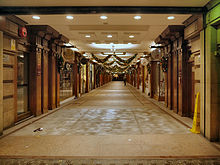Royal Exchange, Manchester
The basement housed a newsroom lit by a dome and plate-glass windows, its ceiling was supported by a circle of Ionic pillars spaced 15 feet from the walls.On trading days merchants and brokers struck deals which supported the jobs of tens of thousands of textile workers in Manchester and the surrounding towns.[7] The exchange was seriously damaged during World War II when it took a direct hit from a bomb during a German air raid in the Manchester Blitz at Christmas in 1940.[10] The Royal Exchange Theatre was founded in 1976 by five artistic directors: Michael Elliott, Caspar Wrede, Richard Negri, James Maxwell and Braham Murray.[5] Its unique design conceived by Richard Negri of the Wimbledon School of Art is intended to create a vivid and immediate relationship between actors and audiences.Shakespeare, Ibsen and Chekhov have been the mainstay of its repertoire but the theatre has staged classics from other areas of the canon including the British premieres of La Ronde and The Prince of Homburg and revivals of The Lower Depths, Don Carlos and The Dybbuk.American work has also been important – Tennessee Williams, O'Neill, Miller, August Wilson – as has new writing, with the world premieres of The Dresser, Amongst Barbarians, A Wholly Healthy Glasgow and Port to its name.The Royal Exchange also presents visiting theatre companies in the Studio; folk, jazz and rock concerts; and discussions, readings and literary events.The many critically acclaimed and award-winning productions include:[23][24][25] In 2005, the Royal Exchange Theatre launched the Bruntwood Playwriting Competition to encourage a new generation of playwrights from the UK and Ireland.The winning entry was Ben Musgrave's Pretend You Have Big Buildings for which he received a prize of £15,000 and his play was performed as part of the Manchester International Festival 2007.According to Braham Murray: -"Although the names have changed we have remained a team of like-minded individuals sharing a common vision of the purpose and potency of theatre.Many other directors have worked at the Royal Exchange amongst them Lucy Bailey, Michael Buffong, Robert Delamere, Jacob Murray, Adrian Noble, Steven Pimlott and Richard Wilson.The company is renowned for its innovative designers, composers and choreographers which include Lez Brotherston, Johanna Bryant, Chris Monks, Alan Price, Jeremy Sams, Rae Smith and Mark Thomas.Actors who have been particularly associated with the Exchange and have appeared in several different productions include : -[23][24] Lorraine Ashbourne, Brenda Blethyn, Tom Courtenay, Amanda Donohoe, Gabrielle Drake, Lindsay Duncan, Ray Fearon, Michael Feast, Robert Glenister, Derek Griffiths, Dilys Hamlett, Julie Hesmondhalgh, Claire Higgins, Paterson Joseph, Cush Jumbo, Ben Keaton, Robert Lindsay, Ian McDiarmid, Tim McInnerny, Janet McTeer, Patrick O'Kane, Daragh O'Malley Trevor Peacock, Maxine Peake, Pete Postlethwaite, Linus Roache, David Schofield, Andy Serkis, Michael Sheen, Andrew Sheridan, David Threlfall and Don Warrington.Kate Winslet, Hugh Grant, David Tennant, Michael Sheen, Andrew Garfield and most recently Gabriel Clark all appeared at the Royal Exchange long before starring in film and television.




Bradshaw, Gass and Hopegrade II listedManchestercity centreSt Ann's SquareMarket StreetManchester Blitz1996 Manchester bombingcommodities exchangeLancashireslave tradeThomas HarrisonClassical stylecolumnsEdmund BuckleyBradshaw Gass & Hopetrading hallCottonopolisWorld War IIGermanPortland stoneatriumrusticatedCorinthianmodillionedcornicebalustradedparapetmansard roofBaroqueturretmullioned windowsartistic directorsMichael ElliottCaspar WredeRichard NegriJames MaxwellBraham MurrayLaurence OlivierGregory HersovIRA bombSt Ann's ChurchBirse GroupNational LotteryCastlefieldPrince EdwardStanley HoughtonHindle WakesSarah FrankcomThe StageThe Stage Awardstheatre in the roundWimbledon School of Artstudio theatrethrustShakespeareChekhovLa RondeThe Lower DepthsDon CarlosThe DybbukTennessee WilliamsO'NeillMillerAugust WilsonThe DresserAmongst BarbariansThe RivalsRichard Brinsley SheridanTom CourtenayChristopher GablePatricia RoutledgeThe Prince of HomburgHeinrich von KleistCasper WredeThe Lady from the SeaVanessa RedgraveRonald HarwoodFreddie JonesThe Duchess of MalfiJohn WebsterAdrian NobleHelen MirrenBob HoskinsPete PostlethwaiteWaiting for GodotSamuel BeckettMax WallTrevor PeacockHamletRobert LindsayMoby DickBrian CoxAs You Like ItNicholas HytnerJanet McTeerRiddley WalkerRussell HobanDavid ThrelfallEdward IIChristopher MarloweIan McDiarmidMichael GrandageSchillerAll My SonsArthur MillerGreg HersovJohn ThawMichael MaloneyMacbethFrancis BarberArms and the ManBernard ShawCatherine RussellAdrian LukisTMA AwardDeath and the King's HorsemanWole SoyinkaPhyllida LloydGeorge HarrisClaire BenedictLorraine AshbourneAndy SerkisRomeo and JulietMichael SheenLook Back in Anger